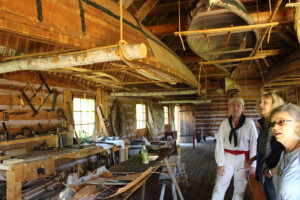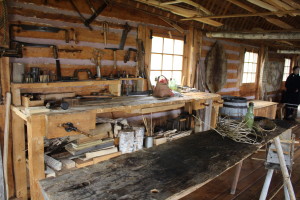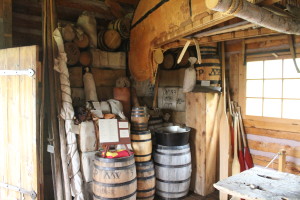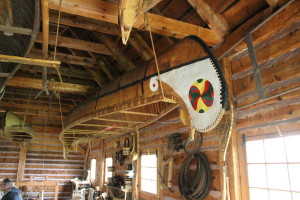
Tom’s favorite place to work at Grand Portage is the Canoe Warehouse. It is probably the favorite place of most of the men because it is the place with all the tools. It doesn’t matter that they aren’t power tools – the men provide the power and the tools work!
The Canoe Warehouse houses a Montreal canoe and a North canoe specially made for Grand Portage. The Montreal canoe is the 38 foot birch bark canoe that was used between Montreal and Grand Portage to bring trade goods to Grand Portage and take furs back to Montreal. A crew of up to 16 men would paddle it and it could hold 9,000 pounds. The North canoes were smaller, about 28 feet, because they needed to negotiate the smaller rivers of the northwest. Eight to 10 men would crew the North Canoes, bringing furs from all over the northwest to Grand Portage and taking trade goods back to their posts. These men would spend the winter at their posts.

The Canoe Warehouse also has a ricing canoe used by a native family for 90 years to harvest wild rice. There is a small child’s canoe and a canoe that was built by the staff here. One of the most interesting things in the Canoe Warehouse is an example of the load that traveled in the Montreal Canoe. The items are from a manifest of the Northwest Company.
The reason all the men like the Canoe Warehouse is because you can work on a project when you are in there and you don’t have any guests. Right now we are building a new birchbark canoe, so most of the men are working on parts for the canoe. But some of them also make other items, such as spoons, paddles, and bowls.

The tools in the warehouse are interesting and we were trained so that we can name most of them and demonstrate their use. There is a spring pole lathe so that you can turn candlesticks, chair legs, bowls, or rolling pins. There are draw knives and shaving horses to work on boards. I spent some time one day using a spoke shaver to thin some ash for barrel hoops. Some of the men like to make buckets which can be used around the site.
In the Canoe Warehouse we tell the story of the Northwest Company and the canoes that transported the goods that were traded. We can also talk about shared technology: the know-how for making birchbark canoes by the Ojibwe and the steel tools used by the traders. Typical questions asked by guests are “How big is that canoe?” and “What is that black stuff on the side of the canoes?”

I like this last question because the answer is pitch that sealed the seams made by sewing the birchbark together with black spruce root. Pitch is made of three ingredients: hardened sap from the spruce tree, powdered charcoal, and bear grease. All canoes carried a repair kit with them at all times because the canoes were prone to leaking and had to be patched almost every day.
The Canoe Warehouse is an interesting place to work and allows us to tell many different stories.
